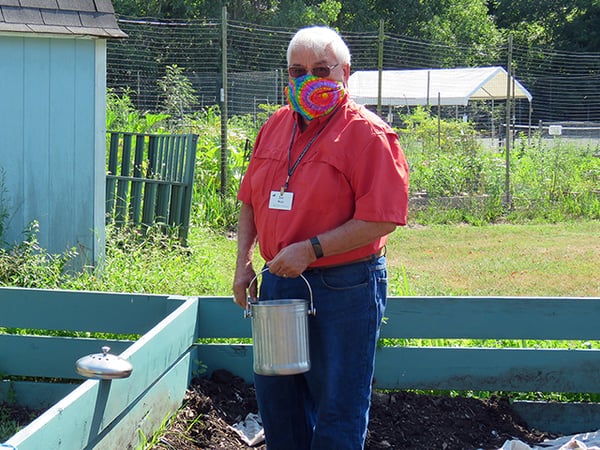Published: June 4, 2021
 Making dirt makes a difference in our environment.
Making dirt makes a difference in our environment.
The U.S. Environmental Protection Agency estimates that in 2018, 2.6 million tons of food (4.1 percent of wasted food) was composted. Americans recovered over 69 million tons of municipal solid waste (MSW) through recycling, and almost 25 million tons through composting. This is 1.16 pounds per person per day for recycling and 0.42 pounds per person per day for composting. Food composting curbside collection programs served 6.1 million households in 2017, the most recent year for which information is available.
Simply put, compost, which is made of food scraps, yard trimmings and other materials, reduces landfill waste while enriching our soil with much needed nutrients.
Many gardeners have turned to composting because its rich, inexpensive earthy soil helps plants thrive, but other people compost because of its positive environmental impact. Maybe it’s time for you to do some dirty work.
Do’s and Don’ts of Composting
The online composting guide published by the Cuyahoga County Solid Waste District is just one of many online sources to learn the basics of compositing. (YouTube videos are also a good source.)
Basic supplies include a bin (which you can buy or build) or outdoor compost area, shovel and aeration tool, thermometer and pail for kitchen scraps. Easy enough but knowing what to compost is key to your success.
Compost “Do’s” include leaves and grass trimmings, eggshells and coffee grounds (tea leaves too), fruits and veggie, and shredded paper and sawdust. Don’t compost meat and fish, pet waste, weeds and yard waste treated with pesticides.
Like any good recipe, you need to have the right mix of ingredients to make compost: 30% green or nitrogen containing organic matter (Vegetables, fruits, flowers, plant clippings, grass clippings, coffee grinds,) and 70% brown or carbon-based organic matter (Dead leaves, straw, sawdust, wood chips, shredded newspaper, corn stalks, cotton rags, nut shells, pine needles).
Your pile needs water and oxygen to “bake” which means at least weekly aeration and checks to make sure the pile has at least 50% moisture content – it should feel damp like a wrung-out sponge.
Concerned about what Ohio.gov calls the “ewwww” factor?
“If your pile smells bad, turn it to make sure it has enough oxygen. Earthworms, sow bugs, pill bugs, centipedes, mites, ground beetles and many other kinds of small living things will find homes in the finished compost and in the garden soil to which compost is added. They help with the decomposition process and add value to the soil.”
And patience, my friend. Composting can take six months or longer in Northeast Ohio (though summer composting is faster). You’ll know it’s ready for garden beds or plants when it resembles small, crumbly, dark-brown particles and that earthy smell.
The folks at Cuyahoga County are offering one-hour Backyard Composting 101 classes on Zoom this summer. The classes are free and open to the public but registration is required. OSU Extension offers free composting videos on-demand.
And to further help you get started, you can purchase bins and other composting items from the county.
Curbside Composting Another Option
Many of us are avid recyclers – we collect glass, paper and other materials and pass along so someone else can process them into something useful.
So maybe curbside composting is more appealing to you. Unfortunately, curbside service is not available nationwide. That said, you and your neighbors might try to interest your waste collection company or community leaders to offer such a service. (For ideas of what communities are doing across the country check out the EPA’s Success Stories.)
Another possible option is to find a nearby drop-off site for your compostable materials.
At Kendal, the Grounds crew composts yard waste, plus residents leave food scraps and materials in a bin, which are collected by a commercial composting service.
Check Out Our New Gardening Guide:
Gardening is a great activity for people of all ages. Get helpful tips here!
 In the past, Molly Kavanaugh frequently wrote about Kendal at Oberlin for the Cleveland Plain Dealer, where she was a reporter for 16 years. Now we are happy to have her writing for the Kendal at Oberlin Community.
In the past, Molly Kavanaugh frequently wrote about Kendal at Oberlin for the Cleveland Plain Dealer, where she was a reporter for 16 years. Now we are happy to have her writing for the Kendal at Oberlin Community.
About Kendal at Oberlin: Kendal is a nonprofit life plan community serving older adults in northeast Ohio. Located about one mile from Oberlin College and Conservatory, and about a 40 minute drive from downtown Cleveland, Kendal offers a vibrant resident-led lifestyle with access to music, art and lifelong learning.




